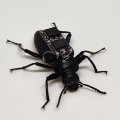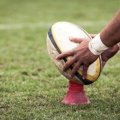A joint project being carried out by Queensland Parks and Wildlife Service (QPWS) and The University of Queensland is attempting to reduce negative human interaction with estuarine crocodiles by tracking their movements.
Former UQ PhD student Dr Mark Read, who heads the QPWS Crocodile Management Unit in Cairns, is attempting to trace the movements of the world’s largest living reptile using satellite-tracking systems placed on crocodiles in the Endeavour River in Cooktown, north Queensland.
He is collaborating with two internationally recognised authorities on the biology and physiology of crocodiles: Professor Gordon Grigg and Dr Craig Franklin from UQ’s School of Life Sciences and the QPWS Crocodile Management Advisory Committee.
Dr Read who is chief investigator on the project said it would help with the management of the potentially dangerous animals.
“At this stage we have limited information on the spatial requirements of large estuarine crocodiles so the contributions this project will make to our knowledge and understanding of how they use space through time will be internationally significant,” Dr Read said.
“This information will not only increase our knowledge of the biology of these animals but it also has implications for the management of this potentially dangerous species throughout its natural range.”
Professor Grigg said satellite transmitters had been attached to the large scales of the nuchal shield on the necks of two crocodiles after one 4.35 metre male and one 2.65 metre female had been caught in baited traps floating in the Endeavour River.
“Both crocodiles were released as close to their capture location as possible and on the same day that they were extracted from the floating traps so the period they were kept from the waterway was kept to a minimum,” Professor Grigg said.
He said the male crocodile had been named Charles after the late Cooktown herpetologist Charles Tanner whose bequest to support research into crocodiles had been instrumental in providing the funding. Mr Tanner is regarded as one of the father’s of herpetology in Australia for his research into reptiles and amphibians.
The female crocodile was named Harriett after Professor Harry Messel, who as Head of the University of Sydney’s School of Physics and later Chancellor of Bond University, had in 1971 first stimulated and supported Professor Grigg’s interest in crocodiles.
He said Professor Messel had been the first person to try to study the movement of estuarine crocodiles by radio telemetry before satellite tracking became available.
“If we’d had two males we would have called the second one Harry but it was a female so we had to call her Harriett. I hope Harry doesn’t mind too much,” Professor Grigg said.
Dr Franklin said the local people had great respect for crocodiles and the project would be a good way to further educate people of the dangers.
“It is about living with crocodiles and making sure the interactions are positive and not negative,” he said.
“Records show that males can grow in excess of seven metres; around one tonne in body mass.”
Dr Franklin said the long-term plan was to attach between 10 and 20 transmitters to crocodiles residing in waterways around Weipa in the north-western Cape York Peninsula.
He said Weipa had been chosen as the main study site because it provided the opportunity to study the movement patterns of crocodiles in remote waterways as well as those residing close to the urban centre.
“Understanding how crocodiles interact with humans and urban areas is a critical component of the overall project,” he said.
Media: For more information, contact Dr Mark Read (email: mark.read@epa.qld.gov.au) or Professor Gordon Grigg (telephone 07 3365 2470, email: ggrigg@zen.uq.edu.au) or Associate professor Craig Franklin (telephone 07 3365 2355, email: cfranklin@zen.uq.edu.au) or Chris Saxby at UQ Communications (telephone 07 3365 2479, email: c.saxby@uq.edu.au).
.jpg)

